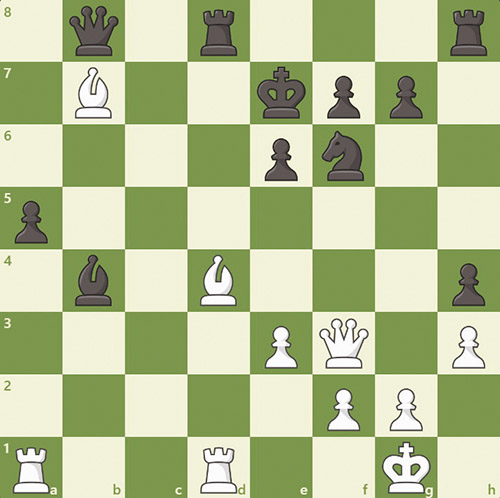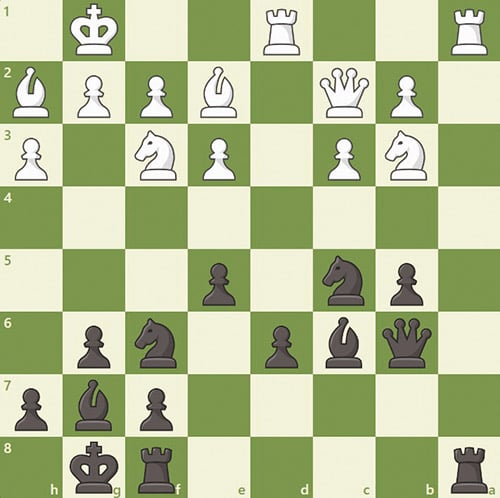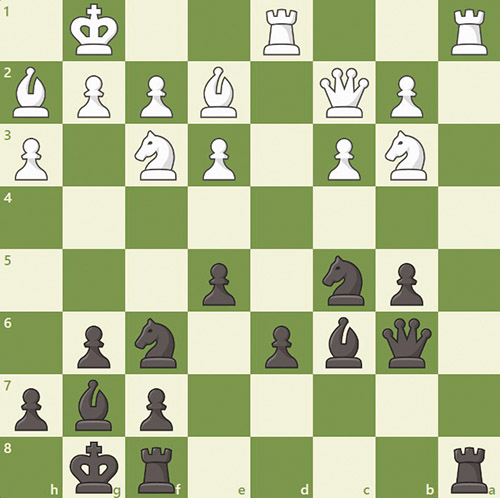

In chess, “removing the guard” is a tactic in which you capture or forcibly move a defensive piece from your opponent’s position, leaving one of their pieces undefended and capturable. The idea is demonstrated in the basic position displayed in Figure 1, where material is equal and both sides of the board are relatively symmetrical with the same pieces and open files. The black bishop, defended by the knight, attacks the white queen, but white wins the game by first playing the knight takes on f6. Because the move comes with a check, black cannot take white’s queen and is forced to recapture the knight. Now that there is no longer a knight on f6 protecting the black bishop on h5, the tables have turned and the white queen can capture the light-squared bishop, winning a piece.

Figure 2 is a position from a game between World Champion Magnus Carlsen with white and Grandmaster Levon Aronian with black at the 2008 Grand Slam Chess Final. Carlsen began with 1. Rab1, centralizing it and preparing a “removing the guard” sacrifice, the winning idea in the position. Aronian responded 1… e5, attacking the dark-squared bishop but allowing Carlsen to play 2. Rxb4, giving up the rook to remove the defender of the c5 square so the white bishop can be moved there on the next move. Here, Aronian had to take the bishop d4 but, in the game, he incorrectly played 2… axb4, allowing Carlsen to launch a devastating queenside attack with 3. Bc5+ Ke6 and the only winning move: 4. Ra1, preparing to attack the black king from the a file. To prevent such a mating attack, Aronian returned the rook sacrifice with the move 4… Rd6 but, while any immediate checkmate is stopped, Carlsen’s devastating strike raged on with

5. Bxd6 Kxd6 6. Qc6+ Ke7. Once more, Carlsen executed the winning tactic of his position and played 7. Ra8, attacking the black queen and if it moves the rook on h8 can be captured. After 7… Qd6 8. Qxd6 Kxd6 9. Ra8, white is up a rook but Aronian still attempted to create counterplay with his passed pawn with the move 9… b3. However, the white pieces are more than capable of stopping the c pawn from promoting so, following 10. Ba6 Nd7 11. Rxh4 Nc5, Aronian resigned.
Figure 3 is from a game that I played last week in the fourth round of the U.S. Amatuer East Chess Tournament against Grandmaster Jianchao Zhou, the strongest player at the event and top 25 in China with a USCF rating of 2633. The Frisch Team, consisting of myself, Jacob Feit, Henry Wildes and James Forman, had reached round four with a high score and was consequently paired against Zhou’s team, one of the strongest at the competition; and because I was playing as the top board and captain of our team, I was matched against the Grandmaster himself. In the position displayed in Figure 3, Zhou, with the black pieces, utilized the concept of removing the defender and played bishop to e4. The move attacks the white queen, forcing it to move from the c2 square and relinquishing its defense of the knight on b3 as the d1 square is occupied by the rook. If, instead of moving the queen, white blocks the attack with bishop to d3, black can simply capture on d3 with the bishop. After rook takes d3 and knight takes d3, if the queen then captures the knight on d3, black has the move pawn to e4, forking the queen and knight on f3. Therefore, I resigned a few moves later and my winning streak was snuffed out.
Figure 4 is a position from a game between Grandmasters Loek van Wely with the white pieces and Judit Polgar with black at the 1997 VAM Hoogeveen tournament. White is up a pawn, attacking the black queen, and seems to be holding his position together. The only winning move here for black, which Polgar found, ignores the threat on the queen and first sacrifices a piece with rook takes f2, removing the guard of the g3 pawn with check. After the white rook captures back on f2, black can now play queen takes g3 and after king to f1, the queen takes the rook on f2 with checkmate.
Ethan Feder is a junior at Yeshivat Frisch, a chess enthusiast and player. The goal of his column is to teach and discuss chess concepts through example positions, high-level games and relevant puzzles, along with explanations. Feel free to contact him with any questions, suggestions or comments at ethan.feder@gmail.com.











